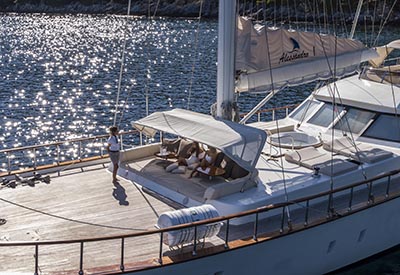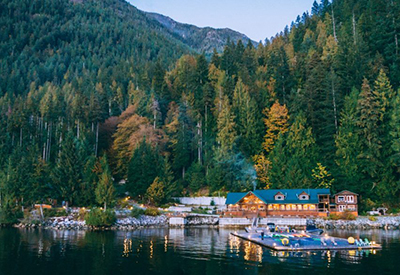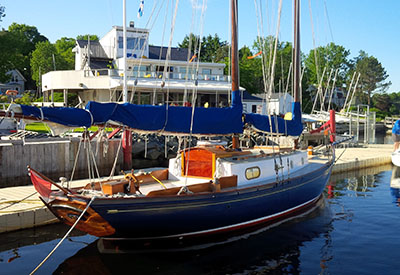Drury Inlet

One of the backroads of the Broughtons, this waterway has much to offer cruisers with a taste for adventure.
Story by Carol-Ann Giroday
Photos by Rick LeBlanc
When July 1 arrives, our bow points northward to the Broughton Archipelago for good scuba diving, kayaking, prawning and crabbing, wilderness hikes and relative isolation. The Broughton Archipelago is a paradise of hundreds of low-lying islands and evergreen- covered rocky islets lying between the bracing waters of Queen Charlotte Strait and the mountainous BC mainland. For most of us, the Broughtons are just far enough away to be a challenge yet close enough to be accessible. Up here, you’re on your own yet within a half-day’s run of civilization.
While the Broughtons can be a popular cruising destination during the summer months, Drury Inlet is among the least traveled waterways in the region. Unlike most mainland inlets, Drury’s head is northwest of its mouth. And its terrain is relatively flat, allowing the prevailing westerly winds to whip down-inlet. Southeast winds can make travel unpleasant here as well. Tidal rapids guard Drury’s mouth and although they are not particularly worrisome, the current in Stuart Narrows can reach seven knots on large tides. Navigation can be challenging beyond Jennis Bay but scenery, excellent anchorages and diversions abound here for those with an adventurous spirit.
We spent five days exploring the nooks and crannies of Drury Inlet: a wilderness where low-lying islands hug the water and great heaves of mountains thrust their peaks heavenward. We visited the new marina at Jennis Bay, went diving near Stuart Narrows, kayaked in and around the Muirhead Islands, and slowly navigated our 40’ Eagle Trawler Sea Foam through the rock-strewn waterway of Actress Passage to explore seldom-travelled Actaeon Sound.
Stuart Narrows
We entered Drury Inlet at slack tide. The Waggoner Cruising Guide notes that slack at Stuart Narrows can be timed at 10 minutes after both high and low tides at Alert Bay. We favoured the south side of the channel, staying clear of Welde Rock in the centre of the narrows. We proceeded to the eastern side of Richmond Bay where we anchored with a view up the inlet to Ligar Islet and beyond. The low surrounding land was forested with second-growth timber – it had obviously been heavily logged over the years and some recent logging scars caught the eye.
Drury Inlet’s most popular anchorages are Richmond Bay, Jennis Bay and Sutherland Bay. All offer reasonable all-weather protection and good holding. Overnight winds were predicted to be variable so we weren’t worried about westerlies blowing in on us.

In our tender we scouted Welde Rock as diving spot and determined it would be tricky to dive in the centre of the channel without someone topside to man the boat and pick us up. We couldn’t anchor our tender easily off the rock without worrying about passing vessels’ wake loosening the anchor’s hold. So we decided to dive along the shoreline of Leche Islet and have a look at lingcod close-up.
After a full day of cruising, we enjoyed a quiet night with a striking red and pink sunset. The next morning’s sky was equally eye-catching. Over a leisurely breakfast we planned to motor Sea Foam three miles west along the inlet to the marina at Jennis Bay.
Jennis Bay Hospitality
Kim and Kent are the managers of the marina property at Jennis Bay which was once owned by Kim’s father, Jerry Major. During her childhood, Kim, along with her mother and six siblings, traveled from their home in Idaho to spend summer vacations in Jennis Bay with their father.
When we arrived at the docks at Jennis Bay we were warmly welcomed by Kim and Kent and their brave one-eyed dog Bravo. Bravo lost his eye fending off a wolf attack one winter night, protecting his family and property. Enthusiastic, eager and very cordial, this young couple work hard to make this a noteworthy stop in Drury Inlet.

The docks here are new and solid, and open all year. There is no power on the dock but in a pinch there is water to fill a dry tank. On a busy summer day, the docks can hold up to 15 mid-size yachts before rafting may be required. There are also suitable places to anchor in the bay north of the marina for those who prefer privacy.
During the summer, dockside festivities include impromptu potluck dinners, happy hours and, fortunately for us, live entertainment on the night we arrived. Fresh crab and prawns caught right outside the bay are in the mix for all visiting boaters to enjoy. The venue, the scenery and the hospitality are incomparable. After a lively toe-tapping time at happy hour we returned to Sea Foam to prepare dinner and wait for another blazing sunset to light up our pilothouse windows.

The next day we motored four miles up Drury Inlet to the Muirhead Islands and anchored in a small notch behind an islet at the northeast end of the group. We were surrounded by a huddle of rocks and islets, exactly the sort of waters where we love to paddle our kayaks.
More small islets – Wilson and Keith Islets to the east and Jenkins Islets to the west – surround the Muirheads. From the Jenkins Islets we could see the large anchorage of Sutherland Bay where just one other boat was on the hook. We enjoyed a gorgeous paddle in the lagoon-like hidden channels among the evergreen-topped islets, under tree limbs coated in lichens and along a shoreline thick with moss.
Actaeon Sound
The following day we took Sea Foam through Actress Passage so we could explore Actaeon Sound to Tsibass Lagoon. Actress Passage is narrow and rock-strewn, with strong currents, so close attention to charts and helm is required. The passage should be transited only at slack, according to our guidebooks. Our captain navigated us through easily with the current still ebbing slightly. We anchored in Skeene Bay and were pleased to find that it was out of the current flow and the prevailing winds. This is a lovely anchorage with a spectacular view of Mount Bullock to the northeast. Unless the winds are coming from the east, it is tranquil and still.
We packed a picnic lunch for a day in our tender and prepared to depart. The round trip up the sound would be 10 miles and the ideal way to see the sights. The narrows just outside our anchorage proved to be the site of the strongest currents.

We motored only as far as the opening of Bond Lagoon because it is only passable for vessels at high tide because of the rocks in its entrance. At the middle of the flood tide, the narrow opening was filling into the lagoon and the water was rushing through. We came as close as we dared but in the turbulent water our sounder was not giving an accurate reading of our depth.
Farther along Actaeon Sound, we came to Creasy Bay on our port side. Along this shore are decades-old ruins from past logging as well as new equipment from operations under way along the hillside up to Creasy Lake. At the head of the bay, a rotting barge driven by a steam donkey offered further evidence of past logging activity.
We stopped for lunch at an abandoned logging float just a short distance past England Point but before Tsibass Lagoon where, when the water ebbs outward, there is such a rush of water flowing that the water near the entrance and along the sound is covered with thick foam.
When we climbed into our tender for the return trip home, clouds had rolled in and the wind had picked up, kicking up a small chop. We ate a late supper and retired after an impressive day of adventure. The wind continued to blow through the night but weakened by morning.
After breakfast we made plans to depart Skeene Bay. High-water slack in Actress Passage would not be until late afternoon but we preferred not want to wait. The tide was still ebbing when Rick took our tender through the area to check the strength and condition of the current flow. He determined that it would be fine to travel through in Sea Foam, preferring to see the rock “alligators” at low tide as long as the current was not too strong.
We passed back through the narrows without incident and pointed Sea Foam eastward into Wells Passage to further explore the beauty of the Broughtons. I thought of two of Kenneth Grahame’s characters in The Wind in the Willows, cautious Mole and boat-loving Water Rat. “Ratty” took Mole on many adventures on his boat and remarked:
“Believe me, my young friend, there is NOTHING – absolutely nothing – half so much worth doing as simply messing about in boats.”
We agree with Ratty!





























